How To Change King Pin On Front End Of An 2014 Ezgo Golf Car
MAINTENANCE
Routine maintenance of the front suspension and steering consists of:
• periodic inspections for loose, worn or damaged components
• alignment checks
• lubrication of ball joints and wheel bearings
Be sure to use merely the recommended lubricants. Maintain the correct adjustment of the front bearings and repack them in accord with the Periodic Service Schedule or if a bearing replacement is required. Routine examination of the tires will provide indications if an alignment is required.
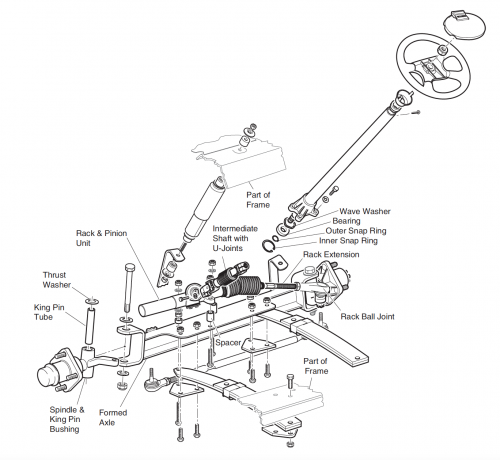
Lubrication
Grease the rack brawl joint. Wipe off old grease that is forced out of rubber boot.
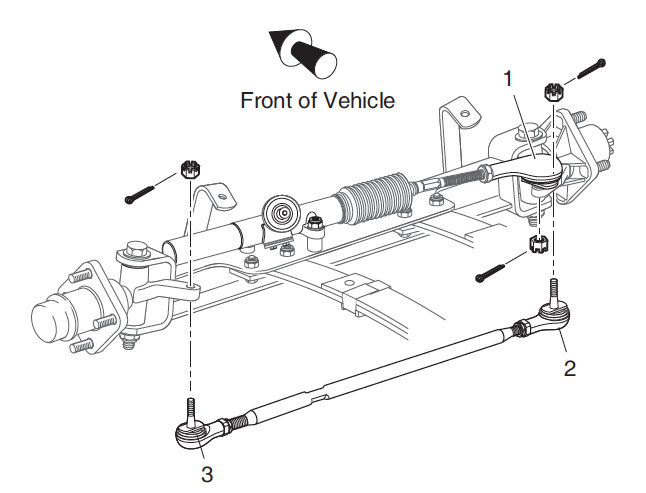
Wheel Bearing and King Pin Bushing Inspection
Lift the forepart of the vehicle and support on jack stands. Rotate the forepart bicycle and feel for any roughness. While belongings spindle with ane hand, grasp bottom of tire with other hand and rock tire back and forth on spindle.
If excess motility is detected, the cycle bearing may require repacking and adjusting or replacement. If the wheel bearing is satisfactory, a worn spindle begetting, which is not a serviceable item, is indicated and the spindle must be replaced.
Wheel Begetting Packing
Remove hub from spindle and disassemble. Clean all bearings, grease seal, hub and dust cap in solvent and dry thoroughly. Inspect for signs of impairment. Pitting or a bluish coloration of the rollers will require replacement of the bearing. If the roller portion of the bearing is to be replaced, the race must also be replaced.
The front wheel bearings are tapered roller type and must exist packed with grease at installation or whatever fourth dimension the bearing is removed for inspection. It is recommended that a bearing packer fastened to a grease gun exist used; yet, manual packing is acceptable if done correctly. To pack a bearing manually requires that a dab
of grease be placed in the palm of the paw and the begetting be dipped in the grease. Force the grease upwards through and around all of the rollers until the entire bearing is saturated in grease. Gather hub and install on spindle.
Wheel Begetting Adjustment
If performing a bike bearing adjustment simply, lift and support front of vehicle. Remove dust cap and cotter pin and loosen castellated nut.
If performing a wheel begetting adjustment as office of some other procedure, make certain wheel is mounted to hub hand tight with lug nuts and hub is loosely retained on spindle with castellated nut. Seat bearings by rotating wheel while tightening castellated nut until slight resistance is felt. Rotate the wheel 2 – iii more turns to readapt backlog grease. If required, tighten castellated nut over again until slight resistance is felt. If the cotter pin hole in the spindle aligns with a slot in the castellated nut, insert a new cotter pin. If the hole does not align, the castellated nut must be loosened to align with the closest available slot in the nut.
Bank check for smooth and gratuitous rotation of the cycle and an absence of play when the cycle is grasped past the outside of the tire. Curve the cotter pivot against the flats of the castellated nut. Replace the grit cap and lower vehicle.
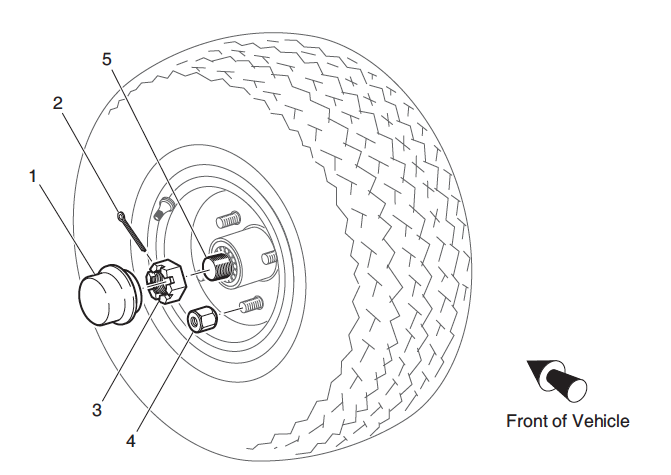
Cycle Alignment
Elevator the front of the vehicle and support on jack stands. Confirm the alignment of the front springs. Rotate each wheel and scribe a chalk line around the circumference of the tire at the middle of the tread blueprint. Lower vehicle and, with tires in the directly ahead position, roll it forward approximately five feet in order to permit the tires to take their normal running position. Measure the distance between the chalk lines at both the front and rear of the tires The measurement taken at the front of the tires should be 0″ – 1/8″ (0 – 3 mm) less than the rear.
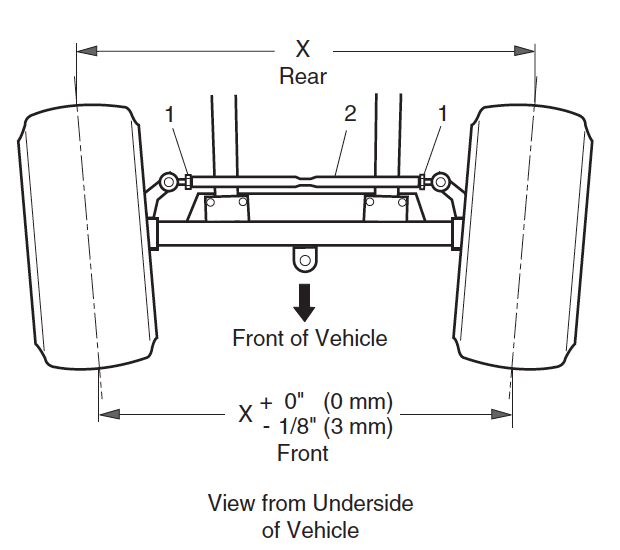
To adjust wheel alignment, loosen tie rod jam nuts and plow necktie rod until correct alignment is achieved. Tighten jam basics to 36 – 40 ft. lbs. (49 – 54 Nm) torque.
Examination drive vehicle and confirm steering wheel is correctly centered. If information technology is not centered, disconnect intermediate shaft from steering shaft and heart steering wheel. Reconnect intermediate shaft and tighten bolt to 155 – 215 in. lbs. (18 – 25 Nm) torque.
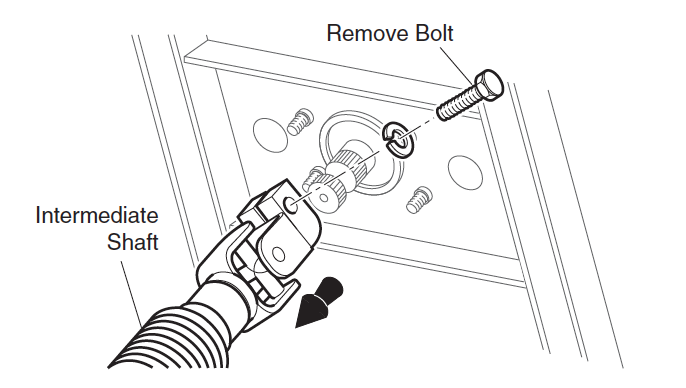
Front Shock Absorber Replacement
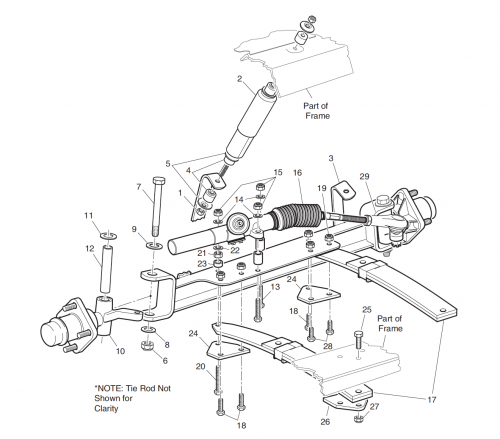
Remove the nut from the bottom of the shock absorber at the front axle. Shrink shock absorber to clear the mounting bracket.
Loosen the nut securing the top of the shock absorber to the vehicle frame and then rotate the daze cushion while belongings the nut in place with a wrench. Remove the shock cushion. Installation of stupor absorber is contrary of disassembly. Mounting nuts should be tightened until rubber bushings expand to diameter of shock absorber washers.
Forepart Axle Replacement
Remove forepart wheels. Remove fittings securing the shock absorbers to front axle. On the commuter side, remove lock nut and washer from bolt and discard nut. Pull commodities and washer from spindle and separate spindle from beam. Remove thrust washer and king pin tube from spindle, wrap towel effectually spindle and let spindle rest on ground. Repeat at passenger side letting rack ball joint residue on front leap to back up spindle. Remove hardware securing rack and pinion unit of measurement to forepart axle and discard lock nuts. Move rack and pinion unit dorsum to residuum on top of front springs. Secure rack and pinion unit to spring with wire to prevent pulling apart intermediate shaft. Remove the three 1 three/4″ long bolts, two ane i/2″ long bolts, bound plate and 5 lock nuts securing axle to springs and discard lock nuts.
At the iii i/two″ long commodities securing front end of left spring, note location of washer and remove it from end of commodities. Remove nut, 3 1/2″ long bolt, leap plate and spacer and retain them for associates at their original locations.
Front axle installation is the opposite order of disassembly using new lock nuts. All hardware must be installed in its original location. Tighten leaf spring and rack and pinion unit hardware to 35 – l ft. lbs (50 – 70 Nm) torque. Install thrust washers, king pivot tubes, spindles, washers and bolts. Tighten new lock basics to 56 – 70 ft. lbs. (75 – 95 Nm) torque. Check that spindle turns freely on king pin tube afterward tightening.
Tighten shock absorber mounting hardware until rubber bushings expand to diameter of daze cushion washer. Check forepart bike alignment and conform if necessary.
Front Bound Replacement
The following process will replace ane spring at a Fourth dimension. Loosen front wheels. Lift and back up forepart of vehicle. In addition, back up front beam with jack stands. Remove front wheels.
To detach driver side spring:
Fully loosen the ii rack and pinion unit lock nuts, 1 nigh the bellows and 1 on the rear side of the rack and pinion unit, until only 1 thread is engaged. Remove the lock nut and washer from the long bolt and discard lock nut.
The rack and pinion unit of measurement is at present loose. Remove the 2 1 3/four″ long bolts and lock basics securing commuter side spring to beam and discard lock nuts.
Concord nut with wrench and loosen long bolt. Notation location of washer and thread long bolt out every bit far equally possible to remove the washer, nut and spacer. Then pull long commodities and spring plate (24) from beam and leap. Retain higher up items for assembly at their original locations. Pull upper driver side of floor mat out of plastic trim retainer and away from floor. Locate and remove hardware securing rear of spring to vehicle frame and discard lock nuts.
Driver side spring installation is the contrary gild of disassembly making sure to install the long commodities, spring plate, spacer, nut and washer in their original locations. Use new lock nuts to secure the rack and pinion unit, two short bolts and rear bolts.
To detach passenger side leap:
Remove the hardware securing the front end of the rider side leafage spring to the axle and discard lock nuts.
Pull upper passenger side of floor mat out of plastic trim retainer and away from flooring. Locate and remove hardware securing rear of bound to vehicle frame and discard lock nuts.
Using new lock nuts, install passenger side jump in the contrary guild of disassembly.
When front end springs are replaced, the front beam must be aligned to the frame. The distance from the center bolt at rear of left leap to the centre bolt at front end of right spring must be the same as the distance from the middle bolt at rear of right spring to the center bolt at front of left leap. Tighten the bound hardware first and rack and pinion unit hardware next to 35 – 50 ft. lbs. (l – seventy Nm) torque.
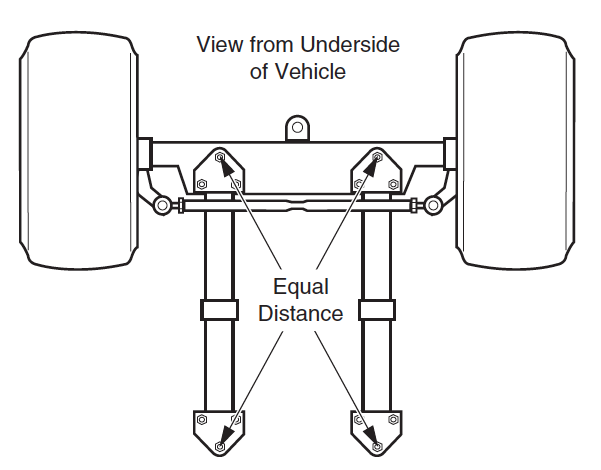
Replace upper portion of floor mat in plastic trim retainers. Install front end wheels and lower vehicle. Check front bicycle alignment and adjust if necessary.
Hub Replacement
Loosen front end bicycle(s). Elevator and support front end of vehicle and remove front wheel(s).
Remove the grit cap, cotter pin and castellated nut. While belongings outer cycle begetting in place, slide hub from spindle and discard.
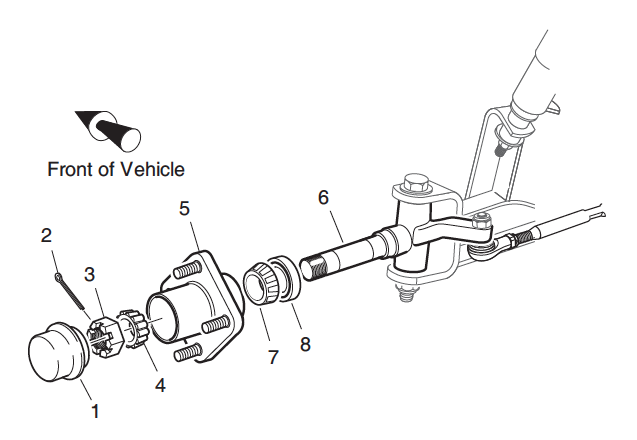
Make clean spindle and new hub thoroughly with solvent. Pack new bearings with grease.
Utilize a light glaze of grease to inner race and place inner wheel bearing in hub. Orient new grease seal and so the flange side of the seal is facing into the bore. Tap gently into place until seal is affluent with finish of hub. Lubricate lips of seal and spindle with grease.
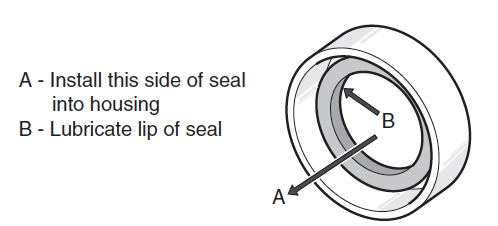
Place new hub onto spindle and fill the area between the ii wheel bearings about 1/2 – three/iv full with grease and apply a light coating to the outer bearing race. Install outer cycle bearing and secure hub loosely with castellated nut. Identify wheel onto hub and hand tighten lug nuts. Suit begetting. Replace the dust cap. Lower vehicle and tighten front end bicycle(s).
Bicycle Bearing and Race Replacement
Remove hub from spindle. Remove the grease seal, inner wheel begetting and bearing races by tapping, through the other side of hub, the bearing race using a hammer and a soft nonferrous dial. Tap race in a circular pattern while moving from side to side to avoid damaging diameter of hub.
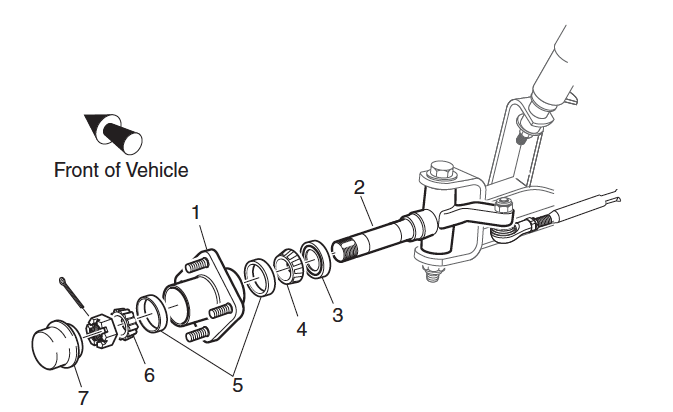
Clean outer bicycle bearing, inner wheel begetting, hub and grit cap in solvent and dry thoroughly. Inspect for signs of damage. Pitting or a blue coloration of the rollers requires replacement of the bearing. If the roller portion of the begetting is to be replaced, the race must also exist replaced. To install race, make certain diameter of hub is clean and place new race over bore of hub. Evenly tap with hammer and bearing driver to bulldoze race fully in bore. Repeat on other side of hub. Clean spindle and pack new bearings with grease.
Install inner bicycle bearing and new grease seal in hub and mount hub to spindle.
Adjust bearing. Replace the grit cap. Lower vehicle and tighten forepart wheel(s).
Rack Ball Joint Replacement
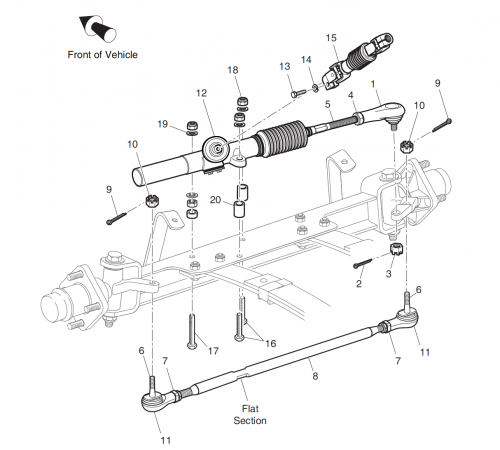
To remove rack ball joint, loosen passenger side front bicycle and elevator and support front of vehicle. Remove passenger side front bicycle and turn steering wheel fully to the left. Remove the cotter pivot and loosen the castellated nut until rack ball articulation threads are protected. Using a ball joint separator equally a lever, utilize force per unit area to brawl joint and tap nut with plastic faced hammer to release ball joint from passenger side spindle arm. Remove nut from ball joint and brawl joint from spindle arm.
To install new rack ball joint close to its correct position, mensurate corporeality of threads exposed from jam nut.
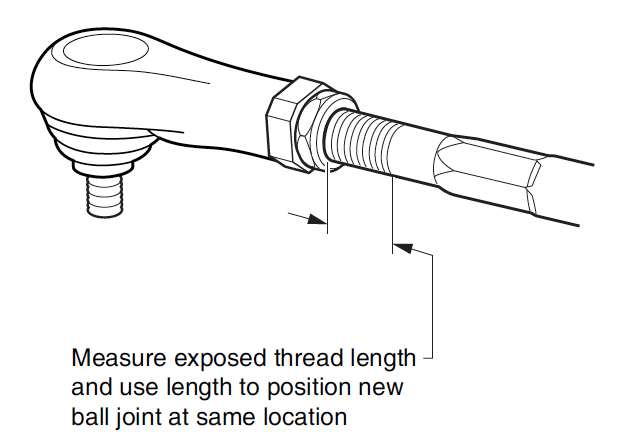
Loosen jam nut and remove rack ball articulation from rack extension. Using measurement made before, thread jam nut and new rack ball joint to previous location on rack extension and set jam nut hand tight. Attach rack ball articulation to spindle arm. Tighten castellated nut to 36 ft. lbs. (l Nm) torque and go along to tighten as needed to insert new cotter pivot. Maximum torque is l ft. lbs. (70 Nm).
Cheque for proper rack extension-to-rack and pinion unit of measurement clearance before tightening jam nut to 35 – 45 ft. lbs. (47 – 61 Nm) torque. Install passenger side front wheel.
Check front cycle alignment and adjust if necessary.
Tie Rod Inspection/Replacement
Grasp the necktie rod at ball joints and bank check for any vertical motion which would bespeak a worn condition and require replacement. To remove tie rod, loosen wheel(s) and lift and support front of vehicle. Remove front bicycle. To install new tie rod ball joint close to its correct position, measure distance to center of ball articulation from jam nut.
Remove cotter pin and loosen castellated nut until tie rod ball articulation threads are protected. Using a brawl articulation separator as a lever, apply pressure level to ball joint and tap nut with plastic faced hammer to release necktie rod from spindle arm. Remove nut to driblet tie rod from spindle arm. Unscrew tie rod ball joint and jam nut from threaded tube.
To install ball joint, first thread on new jam nut and then, using measurement made earlier, screw ball articulation to previous location in threaded tube. Ready jam nut mitt tight.
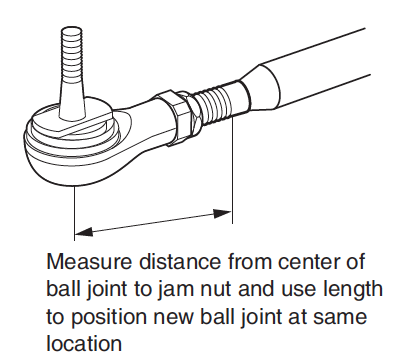
Install safety kick and attach necktie rod to spindle. The castellated nut should be tightened to a minimum of 36 ft. lbs. (50 Nm) torque and continue tightening every bit required in order to insert a new cotter pin. Maximum torque is 50 ft. lbs. (lxx Nm).
A worn tie rod is probable to accept caused incorrect bike alignment. Check front wheel alignment and conform if necessary. Jam nut should be tightened to 36 – 40 ft. lbs. (49 – 54 Nm) torque.
Bellows Replacement
To replace bellows, first loosen rider side forepart wheel and elevator and support front of vehicle. Remove passenger side front wheel and turn steering wheel fully to the left. Remove rack ball joint and jam nut from rack extension. Cut wire ties and slide bellows off rack extension. Install new bellows adjustment small-scale cease over groove in rack extension and secure with new wire tie. Leave large end loose until rack extension-to-rack and pinion unit of measurement clearance is checked or adjusted. Install jam nut and rack ball joint on rack extension and reattach to spindle arm.
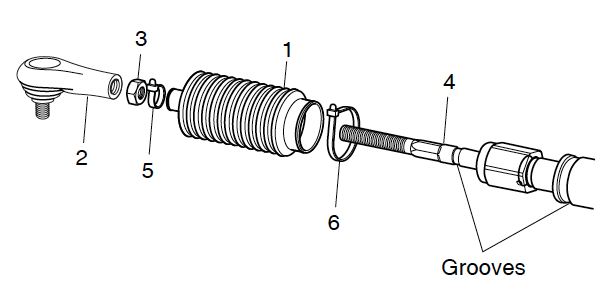
Check for proper rack extension-to-rack and pinion unit clearance before tightening jam nut to 35 – 45 ft. lbs. (47 – 61 Nm) torque. Install passenger side front end wheel and lower vehicle. Check front cycle alignment and arrange if necessary.
Pinion Seal Replacement
To access the pinion seal, remove rack and pinion unit from vehicle. Ballast in vice by clamping on the mounting ears of the rack and pinion unit. Slide a small directly blade screwdriver between lip of seal and pinion and pry peak portion of seal upwardly to remove. Use screwdriver to lift inner portion of seal upward and off pinion. Bank check pinion surface for roughness and sand lightly if needed. Wipe bore clean and lubricate pinion and lip of seal with grease.
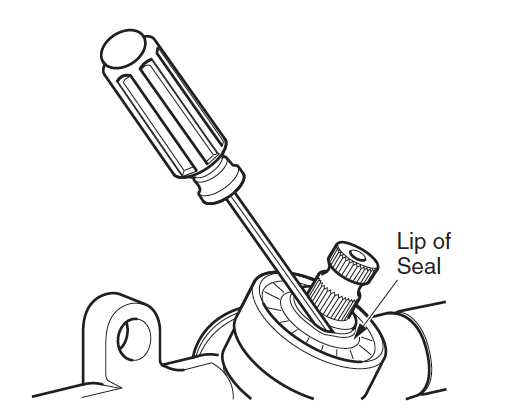
Place seal over pinion and tap carefully with socket and hammer to beginning seal directly in bore. Drive seal fully into diameter until it stops and wipe clean of any backlog grease.
Attach rack and pinion unit to front beam.
Spindle Replacement
Loosen front wheel. Elevator and support front of vehicle and remove front wheel.
Remove cotter pin and loosen castellated nut until necktie rod ball joint threads are protected. Using a brawl joint separator as a lever, apply pressure to ball joint and tap nut with plastic faced hammer to release tie rod from spindle arm. Remove nut from tie rod and necktie rod from spindle arm. If removing passenger side spindle, repeat previous footstep for rack ball joint. Remove lock nut and washer from commodities and discard nut. Pull bolt and washer from spindle and separate spindle from axle. Remove thrust washer and king pin tube from spindle. Spindle installation is the opposite lodge of disassembly.
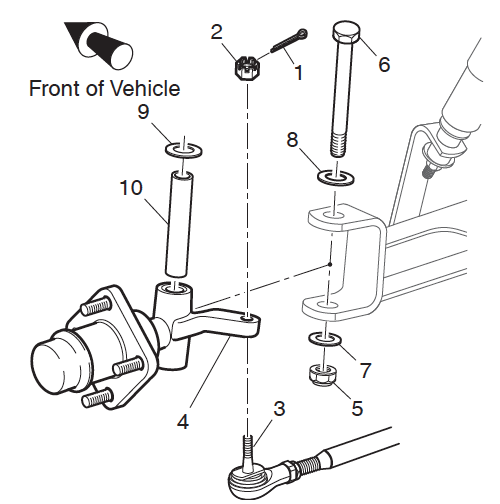
Tighten new lock nut to 56 – 70 ft. lbs. (75 – 95 Nm) torque. Check that spindle turns freely on male monarch pin tube subsequently tightening. Tighten castellated nut to 36 ft. lbs. (50 Nm) torque and go along to tighten as needed to insert new cotter pin. Maximum torque is fifty ft. lbs. (70 Nm). Install front wheels and lower vehicle. Check front wheel alignment and adjust if necessary.
Rack and Pinion Unit Disassembly and Inspection
Remove rack and pinion unit from vehicle. Ballast in vice by clamping on the mounting ears of the unit of measurement. Disassemble rack and pinion unit of measurement past first removing screw and tensioner to relieve pressure on rack and pinion. Loosen jam nut and remove rack ball joint from rack extension. Cutting wire ties securing bellows and slide bellows off rack extension. Pull rack from unit of measurement. Remove pinion seal. Remove internal retaining band from rack and pinion unit of measurement and pull out pinion and ball bearing as an associates.
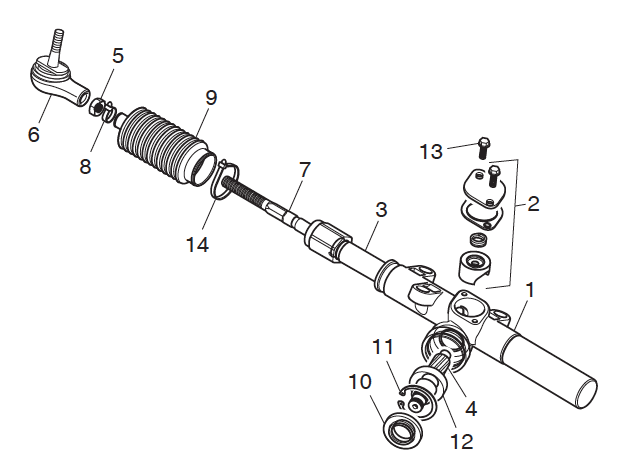
Clean rack, pinion and housing. Inspect gear teeth, bearing surfaces and grease seal surfaces of rack and pinion for excessive wear or impairment. If any is found, the rack and pinion unit must exist replaced as an assembly. If rack and pinion pass inspection, make clean them, tensioner and housing thoroughly and lubricate for assembly.
Employ grease specified in tool list. Assemble rack and pinion unit past kickoff installing pinion in reverse order of removal making sure to lubricate pinion seal lip prior to installing seal. Insert rack into rack and pinion unit. Turn pinion clockwise to aid pull rack in if necessary. Install bellows and secure to rack extension with wire tie. Exercise not secure large end of bellows to rack and pinion unit until instructed to do then after setting proper rack extension-to-rack and pinion unit clearance.
Install tensioner and tighten bolts to 100 – 120 in. lbs. (11.5 – 13.eight Nm) torque. Thread jam nut and rack ball joint to original location on rack extension and prepare jam nut hand tight. Install rack and pinion unit on vehicle.
Prepare proper rack extension-to-rack and pinion unit clearance.
Rack and Pinion Unit of measurement Replacement
To remove rack and pinion unit, loosen front wheels and elevator and support front of vehicle. Remove front end wheels. Remove bolt and washer securing intermediate shaft to rack and pinion unit. Remove cotter pin and loosen castellated nut until rack ball joint threads are protected. Using a ball joint separator every bit a lever, apply pressure to ball joint and tap nut with plastic faced hammer to release ball joint from passenger side spindle arm. Remove nut from ball joint and ball joint from spindle arm. Remove the iii lock nuts securing rack and pinion unit of measurement to front axle and discard basics. The rack and pinion unit tin now be removed from vehicle. Retain washers, spacers and the two bolts for assembly. Replace rack and pinion unit of measurement in reverse guild of removal. Use new lock nuts and tighten them to 35 – 50 ft. lbs. (50 – 70 Nm) torque.
Tighten castellated nut to 36 ft. lbs. (50 Nm) torque and proceed to tighten as needed to insert new cotter pin. Maximum torque is 50 ft. lbs. (70 Nm). Tighten bolt securing intermediate shaft to pinion to 155 – 215 in. lbs. (xviii – 25 Nm) torque.
Prepare proper rack extension-to-rack and pinion unit clearance. Install forepart wheels and lower vehicle. Cheque front wheel alignment and adjust if necessary.
Checking/Adjusting Rack Extension-to-Rack and Pinion Unit Clearance
Check for proper rack extension-to-rack and pinion unit clearance past first turning steering bicycle fully to the right. The rear spindle arm on the rider side must remainder against the front axle. If it does non, all adjustment is fabricated at the rack ball articulation. Loosen jam nut at rack brawl joint and use wrench to thread shaft of rack extension farther into rack ball joint. This will provide more travel for the steering wheel to be turned to the right.
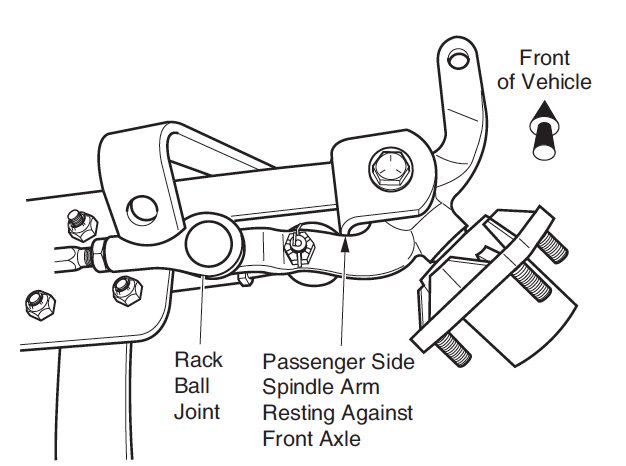
With spindle arm resting against forepart axle, cut wire tie securing bellows to rack and pinion unit and slide bellows away from rack and pinion unit to run into big hex of rack extension. An 1/viii″ gap should exist betwixt the big hex and the end of the rack and pinion unit.
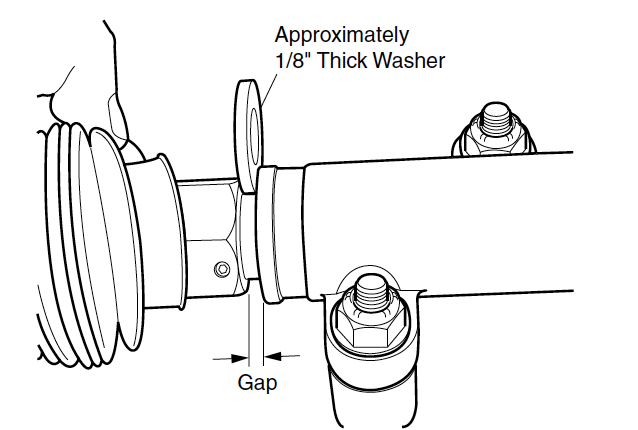
Accommodate, using an ane/8″ thick washer as a estimate, past turning shaft of rack extension with wrench to create the i/viii″ gap. Tighten jam nut to 35 – 45 ft. lbs. (47 – 61 Nm) torque. Secure bellows to rack and pinion unit of measurement with new wire necktie.
Steering Wheel Replacement
From the front side of the steering wheel, remove the clipboard by first pulling straight up on the bottom of the clipboard to release the two bottom retaining tabs. Then, using pollex for leverage as shown, attain from behind steering wheel with fingertips to first pull downward, and so push up to release the two top clipboard retaining tabs.
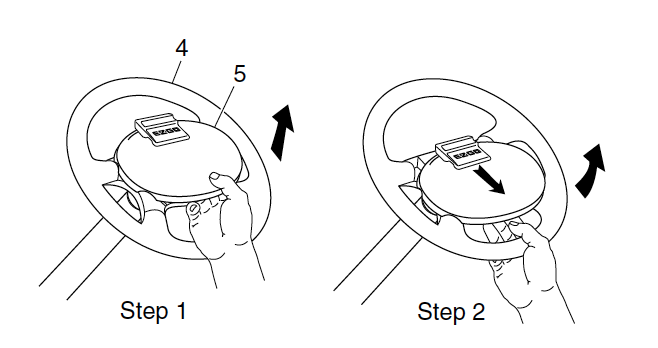
Loosen the steering wheel retaining nut two to three turns. DO Not REMOVE NUT AT THIS Time. Apply upward pressure level to the steering wheel. Place a plastic faced hammer against the steering bicycle nut and strike plastic faced hammer sharply with a ball peen hammer.
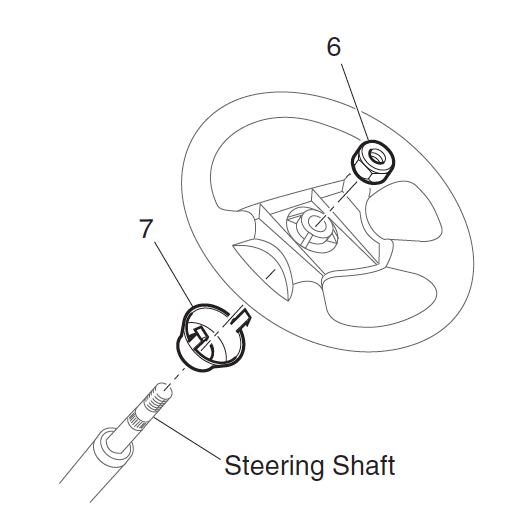
When steering wheel is loosened, remove retaining nut and remove steering wheel.
Prior to replacement, assemble the replacement steering wheel by aligning the retaining tabs on the rear collar hub with slots in back of steering cycle. Squeeze tabs to let insertion of hub. Practice not force. Squeeze hub on tiptop and lesser to fully seat. Replace steering wheel by first lightly blanket the splines of the steering shaft with a commercially available antiseize chemical compound. With the vehicle wheels in the straight ahead position, align the steering wheel on the steering shaft and slide wheel on shaft. Tighten the steering wheel nut to fifteen – 20 ft. lbs. (20 – 27 Nm) torque.
Inspect the iv retaining tabs on the clipboard for white stress lines. If stress lines are present, replace clipboard. Install by carefully pressing, first the elevation two, so the bottom 2 retaining tabs into the matching slots in steering wheel.
Steering Shaft and Column Replacement
To remove steering shaft remove the steering bike. Loosen front wheels. Lift and back up front of vehicle and remove front wheels. Remove the bolt and washer that secures the intermediate shaft to the steering shaft.
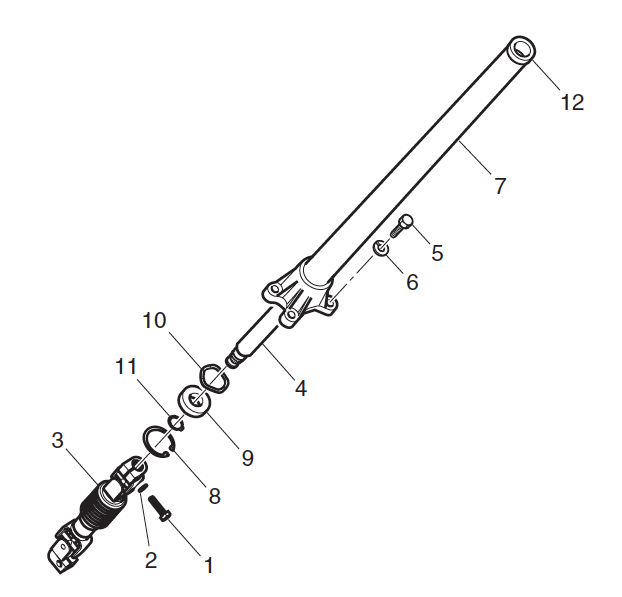
Remove the 4 bolts and washers that secure the steering cavalcade to the chassis and remove the cavalcade. Remove large retaining ring on lesser end of cavalcade and pull shaft and bearing out equally an associates. Slide wave washer out bottom end of steering column and keep for reuse. Remove small retaining ring and printing bearing from steering shaft. To assemble steering shaft, beginning printing new bearing onto shaft until information technology stops against shoulder. Then, with small retaining ring oriented with arch up, slide band onto shaft as far equally possible using snap ring pliers. Apply fingers to push retaining ring fully into groove.
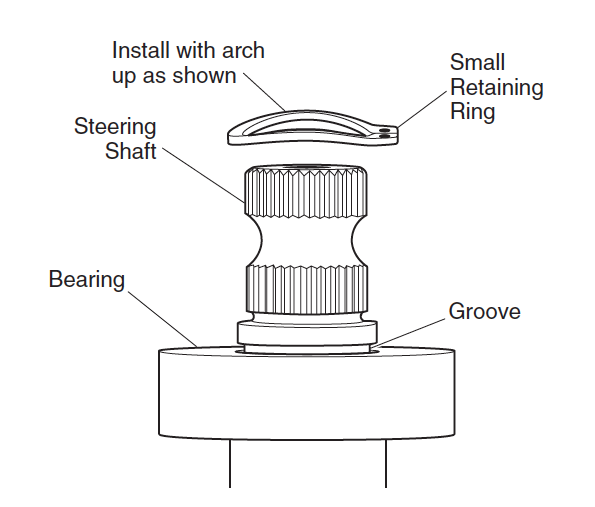
Slide wave washer into base of steering column. To install steering shaft and bearing associates, employ wheel bearing grease to lip of seal in bushing at acme of column and press steering shaft and bearing assembly into column base. Secure with large retaining ring making certain it is fully seated in groove of cavalcade. Place steering column on vehicle and tighten cavalcade bolts to 29 ft. lbs. (39 Nm) torque.
Tighten bolt securing intermediate shaft to steering shaft to 156 – 216 in. lbs. (18 – 25 Nm) torque. Install front wheel(s) and lower vehicle
Source: https://www.ezgogolfcartguide.com/repair-and-service-guides/front-suspension-and-steering/
Posted by: russbrisiong.blogspot.com

0 Response to "How To Change King Pin On Front End Of An 2014 Ezgo Golf Car"
Post a Comment